Impacts of Climate Change and Land Use/Cover Change on the Net Primary Productivity of Vegetation in the Qinghai Lake Basin
Abstract
:1. Introduction
2. Materials and Methods
2.1. Overview of the Study Area
2.2. Data and Preprocessing
2.2.1. Net Primary Productivity (NPP) Data
2.2.2. Land Use/Land Cover (LULC) Data
2.2.3. Meteorological Data
2.2.4. Other Data
2.3. Method
2.3.1. Land Use and Cover Change (LUCC) Analysis
- (1)
- Dynamic degree
- (2)
- Chord Diagram
- (3)
- R-contribution Ratio
2.3.2. Sen-Mann–Kendall Method
2.3.3. Partial Correlation Analysis
3. Results
3.1. Spatio-Temporal Variation of Land Use/Land Cover (LULC) in Qinghai Lake Basin from 2000 to 2020
3.2. Analysis of Land Use and Cover Change (LUCC) in Qinghai Lake Basin from 2000 to 2020
3.3. Analysis of Changes of Net Primary Productivity (NPP) of Qinghai Lake Basin
4. Discussion
4.1. Analysis of the Effect of Changes in Land Use/Cover Change (LUCC) on the Vegetation NPP
4.2. Analysis of the Effects of Climate Change on Vegetation Net Primary Productivity (NPP)
4.3. Analysis of Other Factors and Net Primary Productivity (NPP) of Qinghai Lake Basin
5. Conclusions
Author Contributions
Funding
Institutional Review Board Statement
Informed Consent Statement
Data Availability Statement
Conflicts of Interest
References
- IPCC. Climate Change 2013: The Physical Science Basis; Working Group I Contribution to the IPCC Fifth Assessment Report (AR5); IPCC: New York, NY, USA, 2013. [Google Scholar]
- Reay, D.S.; Dentener, F.; Smith, P.; Grace, J.; Feely, R.A. Global nitrogen deposition and carbon sinks. Nat. Geosci. 2008, 1, 430–437. [Google Scholar] [CrossRef]
- Lee, M.; Manning, P.; Rist, J.; Power, S.A.; Marsh, C. A global comparison of grassland biomass responses to CO2 and nitrogen enrichment. Philos. Trans. R. Soc. B—Biol. Sci. 2010, 365, 2047–2056. [Google Scholar] [CrossRef] [PubMed] [Green Version]
- Sharma, S.; Joshi, P.K.; Fürst, C. Exploring Multiscale Influence of Urban Growth on Landscape Patterns of Two Emerging Urban Centers in the Western Himalaya. Land 2022, 11, 2281. [Google Scholar] [CrossRef]
- Canadell, J.G.; Pataki, D.E.; Pitelka, L.F. Terrestrial Ecosystems in a Changing World; Springer: Berlin/Heidelberg, Germany, 2007. [Google Scholar]
- Song, B.; Niu, S.L. Global change and terrestrial carbon cycle: A review. J. Southwest Univ. Natl. (Nat. Sci. Ed.) 2016, 42, 14–23. (In Chinese) [Google Scholar]
- Li, J.; Cui, Y.P.; Liu, J.Y.; Shi, W.J.; Qin, Y.C. Estimation and analysis of net primary productivity by integrating MODIS remote sensing data with a light use efficiency model. Ecol. Model. 2013, 252, 3–10. [Google Scholar] [CrossRef]
- Zhang, M.M.; Kafy, A.A.; Xiao, P.N.; Han, S.Y.; Zou, S.J.; Saha, M.L.; Zhang, C.; Tan, S.K. Impact of urban expansion on land surface temperature and carbon emissions using machine learning algorithms in Wuhan, China. Urban Clim. 2023, 47, 101347. [Google Scholar] [CrossRef]
- Haberl, H.; Erb, K.H.; Krausmann, F.; Gaube, V.; Bondeau, A.; Plutzar, C.; Gingrich, S.; Lucht, W.; Fischer–Kowalski, M. Quantifying and mapping the human appropriation of net primary production in earth’s terrestrial ecosystems. Proc. Natl. Acad. Sci. USA 2007, 104, 12942–12947. [Google Scholar] [CrossRef] [Green Version]
- Zhang, M.L.; Lal, R.; Zhao, Y.Y.; Jiang, W.L.; Chen, Q.G. Spatial and temporal variability in the net primary production of grassland in China and its relation to climate factors. Plant Ecol. 2017, 218, 1117–1133. [Google Scholar] [CrossRef]
- Guo, E.L.; Liu, X.P.; Zhang, J.Q.; Wang, Y.F.; Wang, C.L. Assessing spatiotemporal variation of drought and its impact on maize yield in Northeast China. J. Hydrol. 2017, 55, 231–247. [Google Scholar] [CrossRef]
- Qi, J.G.; Tao, S.Q.; Pueppke, S.G.; Espolov, T.E.; Beksultanov, M.; Chen, X.; Cai, X.M. Changes in land use/land cover and net primary productivity in the transboundary Ili-Balkhash basin of Central Asia, 1995–2015. Environ. Res. Commun. 2020, 2, 011006. [Google Scholar] [CrossRef]
- Zhang, M.M.; Kafy, A.A.; Ren, B.; Zhang, Y.W. Application of the Optimal Parameter Geographic Detector Model in the Identification of Influencing Factors of Ecological Quality in Guangzhou, China. Land 2022, 11, 1303. [Google Scholar] [CrossRef]
- Yang, S.L.; Bai, Y.; Alatalo, J.M.; Wang, H.M.; Tong, J.P.; Liu, G.; Zhang, F.; Chen, J.Y. Spatial–temporal pattern of cultivated land productivity based on net primary productivity and analysis of influencing factors in the Songhua River basin. Land Degrad. Dev. 2022, 33, 1917–1932. [Google Scholar] [CrossRef]
- De Jong, R.; Schaepman, M.E.; Furrer, R.; De Bruin, S.; Verburg, P.H. Spatial relationship between climatologies and changes in global vegetation activity. Glob. Change Biol. 2013, 19, 1953–1964. [Google Scholar] [CrossRef]
- Zhao, F.; Xu, B.; Yang, X.C.; Xia, L.; Jin, Y.X.; Li, J.Y.; Zhang, W.B.; Guo, J.; Shen, G. Modelling and analysis of net primary productivity and its response mechanism to climate factors in temperate grassland, Northern China. Int. J. Remote Sens. 2019, 40, 2259–2277. [Google Scholar] [CrossRef]
- Wang, Q.; Yang, Y.; Liu, Y.Y.; Tong, L.J.; Zhang, Q.P.; Li, J.L. Assessing the Impacts of Drought on Grassland Net Primary Productivity at the Global Scale. Sci. Rep. 2019, 9, 14041. [Google Scholar] [CrossRef] [Green Version]
- Mowll, W.; Blumenthal, D.M.; Cherwin, K.; Smith, A.; Symstad, A.J.; Vermeire, L.T.; Collins, S.L.; Smith, M.D.; Knapp, A.K. Climatic controls of aboveground net primary production in semi–arid grasslands along a latitudinal gradient portend low sensitivity to warming. Oecologia 2015, 177, 959–969. [Google Scholar] [CrossRef] [Green Version]
- Li, C.H.; Zhou, M.; Dou, T.B.; Zhu, T.B.; Yin, H.H.; Liu, L.H. Convergence of global hydrothermal pattern leads to an increase in vegetation net primary productivity. Ecol. Indic. 2021, 132, 108282. [Google Scholar] [CrossRef]
- Khalifa, M.; Elagib, N.A.; Ribbe, L.; Schneider, K. Spatio–temporal variations in climate, primary productivity and efficiency of water and carbon use of the land cover types in Sudan and Ethiopia. Sci. Total Environ. 2018, 624, 790–806. [Google Scholar] [CrossRef]
- Peng, D.L.; Wu, C.Y.; Zhang, B.; Huete, A.; Zhang, X.Y.; Sun, R.; Lei, L.P.; Huang, W.J.; Liu, L.Y.; Liu, X.J.; et al. The influences of drought and Land–Cover Conversion on Inter–Annual Variation of NPP in the Three–North Shelterbelt Program Zone of China Based on MODIS Data. PLoS ONE 2016, 11, e0158173. [Google Scholar] [CrossRef] [Green Version]
- Jiao, W.; Chen, Y.N.; Li, W.H.; Zhu, C.G.; Li, Z. Estimation of net primary productivity and its driving factors in the Ili River Valley, China. J. Arid Land 2018, 10, 781–793. [Google Scholar] [CrossRef] [Green Version]
- Ardo, J.; Tagesson, T.; Jamali, S.; Khatir, A. MODIS EVI based net primary production in the Sahel 2000-2014. Int. J. Appl. Earth Obs. Geoinf. 2018, 65, 35–45. [Google Scholar] [CrossRef]
- Kamali, A.; Khosravi, M.; Hamidianpour, M. Spatial–temporal analysis of net primary productivity (NPP) and its relationship with climatic factors in Iran. Environ. Monit. Assess. 2020, 192, 718. [Google Scholar] [CrossRef]
- Chen, T.; Bao, A.M.; Jiapaer, G.L.; Guo, H.; Zheng, G.X.; Jiang, L.L.; Chang, C.; Tuerhanjiang, L. Disentangling the relative impacts of climate change and human activities on arid and semiarid grassland in Central Asia during 1982–2015. Sci. Total Environ. 2019, 653, 1311–1325. [Google Scholar] [CrossRef] [PubMed]
- Yang, H.F.; Hu, D.D.; Xu, H.; Zhong, X.N. Assessing the spatiotemporal variation of NPP and its response to driving factors in Anhui province, China. Environ. Sci. Pollut. Res. 2020, 27, 14915–14932. [Google Scholar] [CrossRef]
- Xiao, T.; Wang, J.B.; Chen, Z.Q. Vulnerability of grassland ecosystems in the Sanjiangyuan region based on NPP. Resour. Sci. 2010, 32, 323–330. [Google Scholar]
- Zhu, Y.H.; Xi, X.K.; Ma, P.F.; Yu, T.; Zhang, J. Spatiotemporal variation of vegetation net primary productivity and its influencing factors. J. Inn. Mong. Agric. Univ. (Nat. Sci. Ed.) 2022, 43, 21–26. (In Chinese) [Google Scholar]
- Yan, M.; Xue, M.; Zhang, L.; Tian, X.; Chen, B.W.; Dong, Y.Q. A Decade’s Change in Vegetation Productivity and Its Response to Climate Change over Northeast China. Plants 2021, 10, 821. [Google Scholar] [CrossRef]
- Zhao, P.; Wang, D.J.; He, S.T.; Lan, H.J.; Chen, W.L.; Qi, Y.C. Driving forces of NPP change in debris flow prone area: A case study of a typical region in SW China. Ecol. Indic. 2020, 119, 106811. [Google Scholar] [CrossRef]
- Qiao, K.; Guo, W. Estimating Net Primary Productivity of Alpine Grassland in Qinghai Lake Basin. Bull. Soil Water Conserv. 2016, 36, 204–209. (In Chinese) [Google Scholar]
- Li, L.; Zhang, F.P.; Feng, Q.; Wang, H.W.; Wei, Y.F.; Li, X.J.; Nie, S.; Liu, J.Y. Responses of grassland to climate change and human activities in the area around Qinghai Lake. Chin. J. Ecol. 2019, 38, 1157–1165. (In Chinese) [Google Scholar]
- Zhang, T.; Cao, G.C.; Cao, S.K.; Chen, K.L.; Shan, Z.X.; Zhang, J. Spatial-temporal characteristics of the vegetation net primary production in the Qinghai Lake basin from 2000 to 2012. J. Desert Res. 2015, 35, 1072–1080. [Google Scholar]
- Peng, S. 1–km Monthly Precipitation Dataset for China (1901–2021); National Tibetan Plateau Data Center: Beijing, China, 2020. [Google Scholar] [CrossRef]
- Shen, Y. Map of Permafrost Distribution in the Qilian Mountains; National Tibetan Plateau Data Center: Beijing, China, 2020. [Google Scholar] [CrossRef]
- Wang, X.L.; Bao, Y.H. Study on the methods of land use dynamic change research. Prog. Geogr. 1999, 18, 81–87. [Google Scholar]
- Wang, Z.L.; Ye, H.; Zhang, L.Y. Understanding the characteristics and mechanism of land use transition in mountainous economic zone: A case study of the Chengdu–Chongqing region in southwestern China. Front. Environ. Sci. 2022, 10, 1743. [Google Scholar] [CrossRef]
- Fyfe, R.M.; Woodbridge, J.; Roberts, C.N. Trajectories of change in Mediterranean Holocene vegetation through classification of pollen data. Veg. Hist. Archaeobot. 2018, 27, 351–364. [Google Scholar] [CrossRef]
- Fu, Y.C.; Lu, X.Y.; Zhao, Y.L.; Zeng, X.T.; Xia, L.L. Assessment impacts of weather and land Use/Land Cover (LUCC) Change on urban vegetation Net Primary Productivity (NPP): A case study in Guangzhou, China. Remote Sens. 2013, 5, 4125–4144. [Google Scholar] [CrossRef] [Green Version]
- Hicke, J.A.; Lobell, D.B.; Asner, G.P. Cropland area and net primary production computed from 30 years of USDA agricultural harvest data. Earth Interact 2004, 8, 1–20. [Google Scholar] [CrossRef]
- Sen, P.K. Estimates of the Regression Coefficint Based on Kendall’s Tau. J. Am. Stat. Assoc. 1968, 63, 1379–1389. [Google Scholar] [CrossRef]
- Yue, S.; Wang, C.Y. Applicability of prewhitening to eliminate the influence of serial correlation on the Mann-Kendall test. Water Resour. Res. 2002, 38, 1068. [Google Scholar] [CrossRef]
- Aditya, F.; Gusmayanti, E.; Sudrajat, J. Rainfall trend analysis using Mann–Kendall and Sen’s slope estimator test in West Kalimantan. IOP Conf. Ser. Earth Environ. Sci. 2021, 893, 012006. [Google Scholar] [CrossRef]
- Agarwal, S.; Kumar, S. Urban flood modeling using SWMM for historical and future extreme rainfall events under climate change scenario. Indian J. Ecol. 2020, 47, 48–53. [Google Scholar]
- Jiang, H.; Wu, Y.F. Change trend analysis of the time–series shadow–eliminated vegetation index (SEVI) for the Wuyishan Nature Reserve with the Sen+Mann–Kendall method. IOP Conf. Ser. Earth Environ. Sci. 2021, 658, 012016. [Google Scholar] [CrossRef]
- Liu, J.H.; Gao, J.X. Effects of climate and land use change on the changes of NPP in the Farming–Pastoral Ecotone of Northern China. Resour. Sci. 2009, 31, 493–500. (In Chinese) [Google Scholar]
- Wang, Y.H.; Tang, W.J.; Li, S.; Zhao, H.Y.; Xie, J.L.; Ma, C.; Yan, C.Z. Change in grassland productivity in Qinghai Province and its driving factors. Acta Prataculturae Sin. 2022, 31, 1–13. (In Chinese) [Google Scholar]
- Zhou, W.; Gang, C.C.; Zhou, F.C.; Li, J.L.; Dong, X.G.; Zhao, C.Z. Quantitative assessment of the individual contribution of climate and human factors to desertification in northwest China using net primary productivity as an indicator. Ecol. Indic. 2015, 48, 560–569. [Google Scholar] [CrossRef]
- Wang, H.; Liu, G.H.; Li, Z.S.; Ye, X.; Wang, M.; Gong, L. Impacts of climate change on net primary productivity in arid and semiarid regions of China. Chin. Geogr. Sci. 2016, 26, 35–47. [Google Scholar] [CrossRef]
- Jia, J.H. The Relative Importance of Climate Change and Human Activities on the Change of vegetation NPP at Different Time Scales in Northwest China. Master’s Thesis, Nanjing Normal University, Nanjing, China, 2018. (In Chinese). [Google Scholar]
- Wang, H.W.; Qi, Y.; Lian, X.H.; Zhang, J.L.; Yang, R.; Zhang, M.T. Effects of climate change and land use/cover change on the volume of the Qinghai Lake in China. J. Arid Land 2022, 14, 245–261. [Google Scholar] [CrossRef]
- Guo, X.Y.; He, Y.; Shen, Y.P.; Feng, D. Analysis of the Terrestrial NPP based on the MODIS in the Source Regions of Yangtze and Yellow Rivers from 2000 to 2004. J. Glaciol. Geocryol. 2006, 4, 512–518. (In Chinese) [Google Scholar]
- He, Y.; Dan, L.; Dong, W.J.; Qin, D.H. The terrestrial NPP simulations in China since Last Glacial Maximum. Chin. Sci. Bull. 2005, 50, 2074–2079. [Google Scholar] [CrossRef]
- Liang, W.; Yang, Y.T.; Fan, D.M.; Guan, H.D.; Zhang, T.; Long, D.; Zhou, Y.; Bai, D. Analysis of spatial and temporal patterns of net primary production and their climate controls in China from 1982 to 2010. Agric. For. Meteorol. 2015, 204, 22–36. [Google Scholar] [CrossRef]
- Li, Y.C.; Li, Z.S.; Zhang, X.P.; Yang, A.L.; Gui, J.; Xue, J. Spatial and temporal changes in vegetation cover and response to human activities in Qilian Mountain National Park. Acta Ecol. Sin. 2023, 1, 1–15. (In Chinese) [Google Scholar]
- Zhou, Y.Y.; Yue, D.X.; Li, C.; Mu, X.L.; Guo, J.J. Identifying the spatial drivers of net primary productivity: A case study in the Bailong River Basin, China. Glob. Ecol. Conserv. 2021, 28, e01685. [Google Scholar] [CrossRef]
- Sun, L.X.; Yu, Y.; Gao, Y.T.; Zhang, H.Y.; Yu, X.; He, J.; Wang, D.G.; Ireneusz, M.; Malgorzata, W.; Yu, R. Temporal and spatial variations of net primary production and its response to groundwater of a typical oasis in the Tarim Basin, China. J. Arid Land 2021, 13, 1142–1154. [Google Scholar] [CrossRef]
- Shen, M.G.; Piao, S.L.; Dorji, T.; Liu, Q.; Cong, N.; Chen, X.Q.; An, S.; Wang, S.P.; Wang, T.; Zhang, G.X. Plant phenological responses to climate change on the Tibetan Plateau: Research status and challenges. Natl. Sci. Rev. 2015, 2, 454–467. [Google Scholar] [CrossRef] [Green Version]
- Wang, T. The progress of research on aeolian desertification. Bull. Chin. Acad. Sci. 2009, 24, 290–296. (In Chinese) [Google Scholar]
- Zhou, W.; Gang, C.C.; Zhou, L.; Chen, Y.Z.; Li, J.L.; Ju, W.M.; Odeh, I. Dynamic of grassland vegetation degradation and its quantitative assessment in the northwest China. Acta Oecologica 2014, 55, 86–89. [Google Scholar] [CrossRef]
- Zhang, M. Indicator system and assessment of land desertification in Qinghai–Lake area based on remote sensing. Territ. Nat. Resour. Study 2016, 3, 35–37. (In Chinese) [Google Scholar]
- Wang, T.; Song, X.; Yan, C.Z.; Li, S.; Xie, J.L. Remote sensing analysis on aeolian desertification trends in Northern China during 1975–2010. J. Desert Res. 2011, 31, 1351–1356. (In Chinese) [Google Scholar]
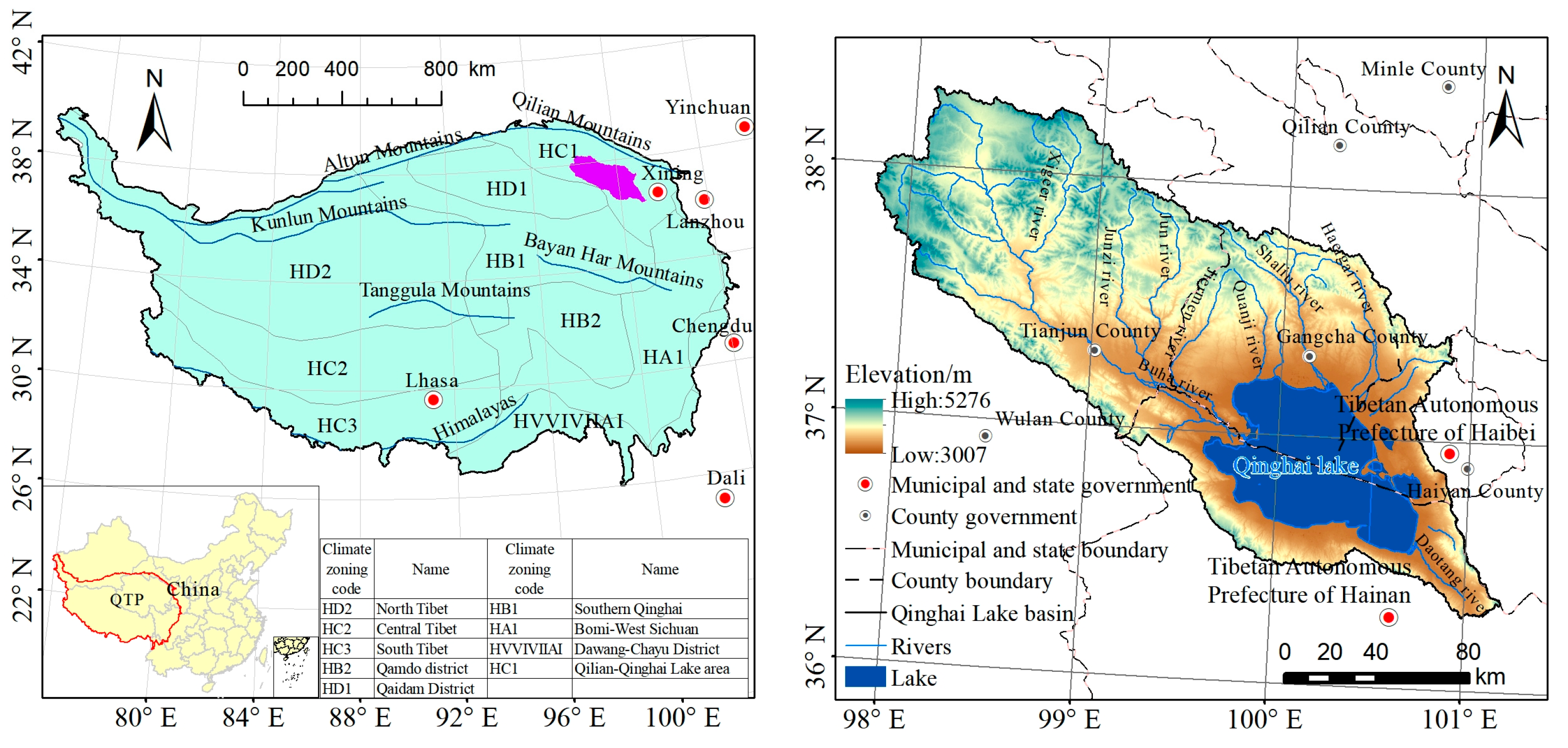
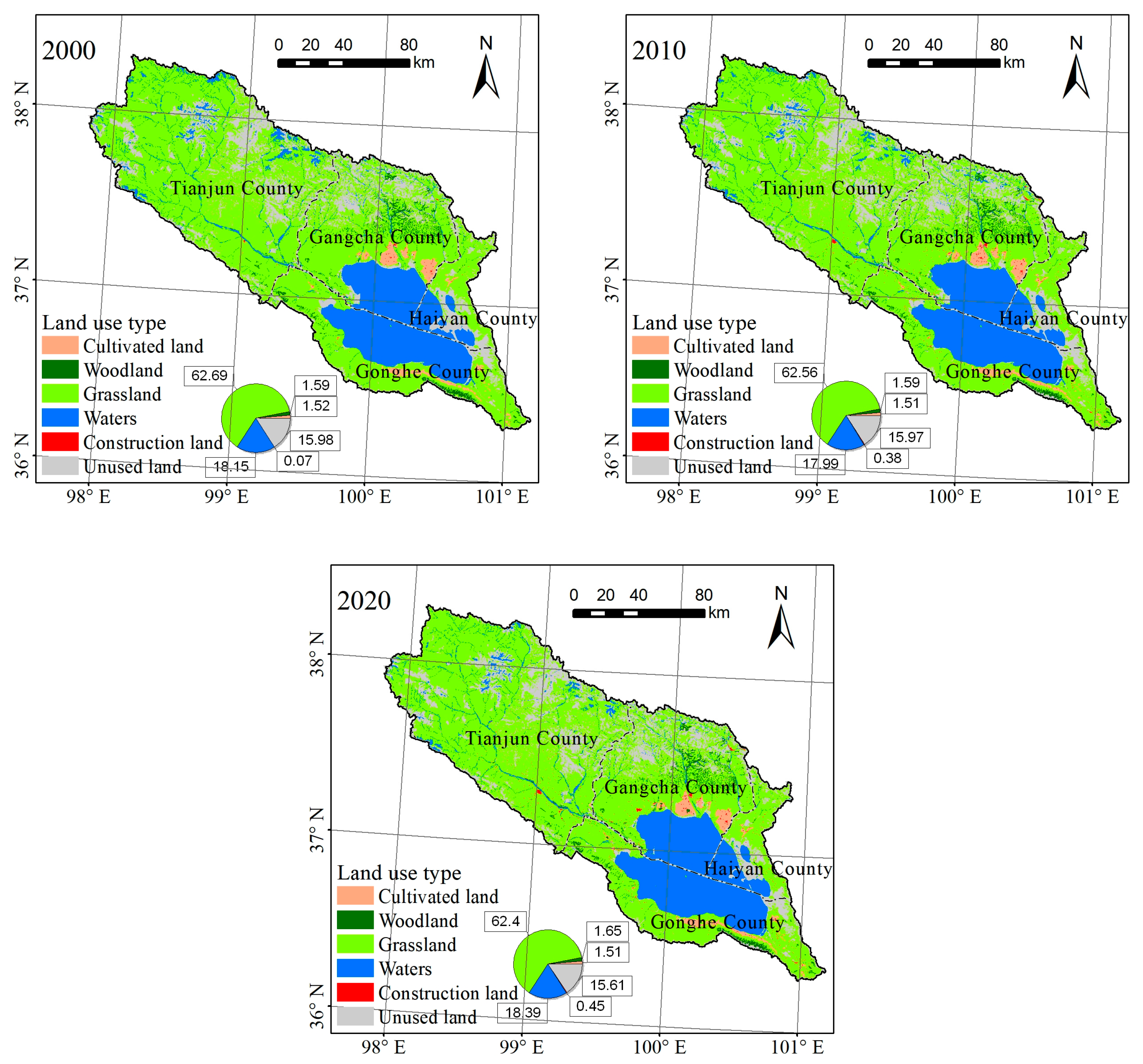
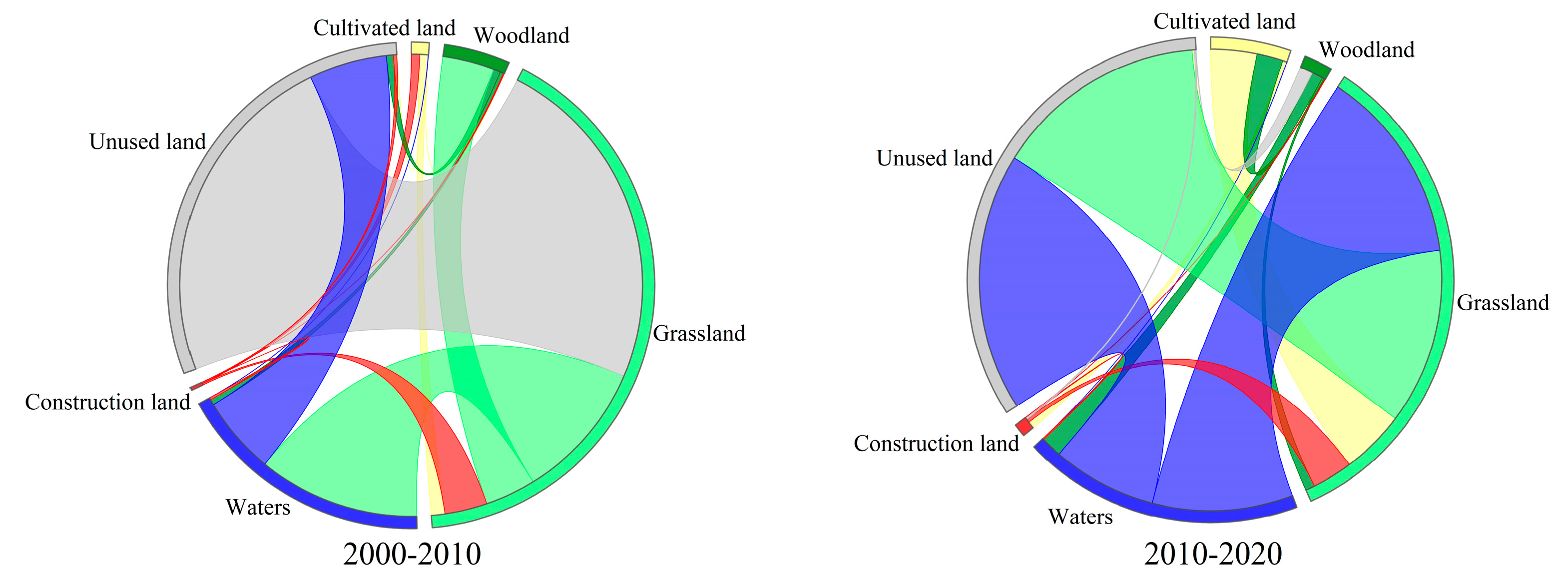
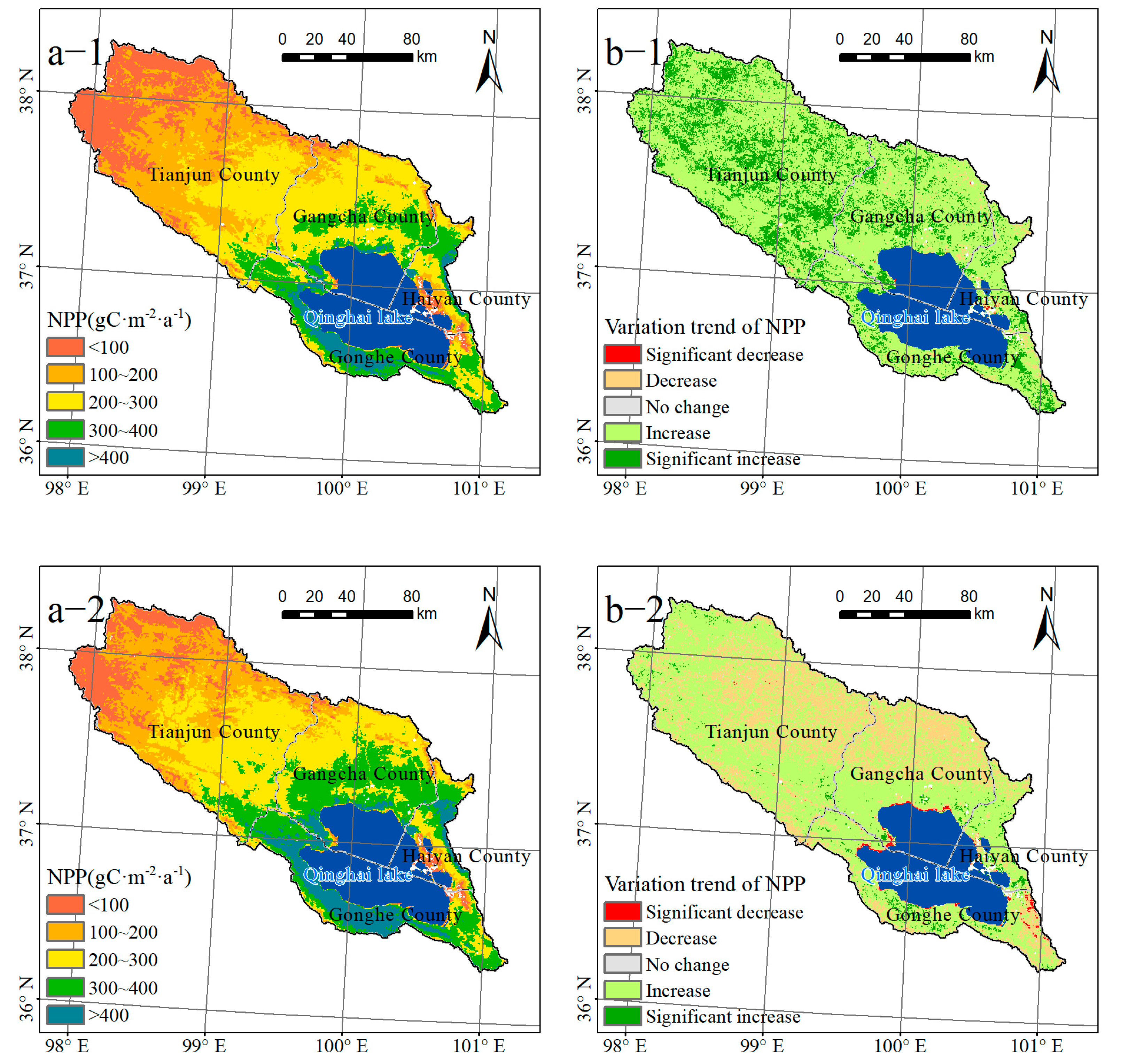


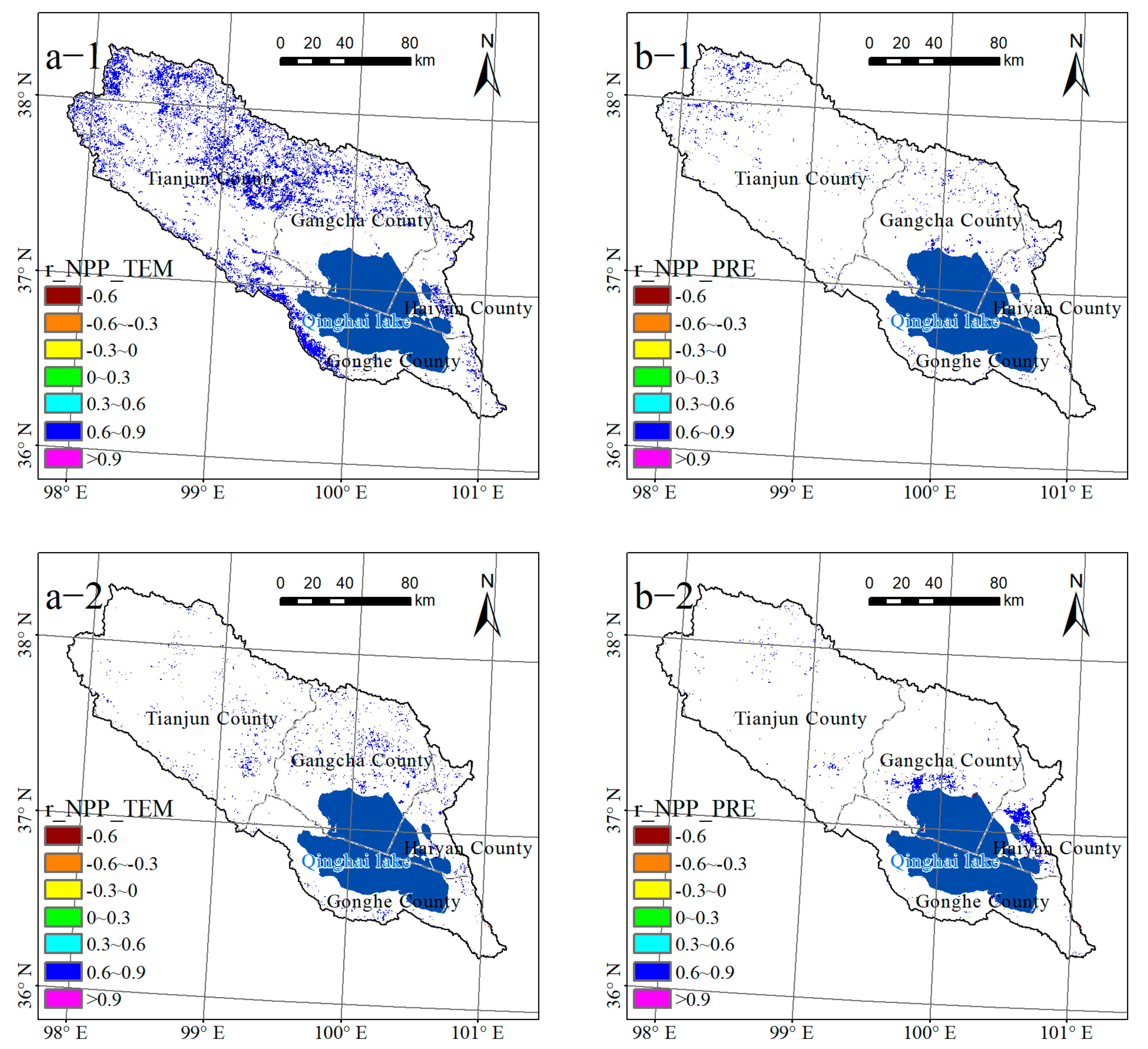
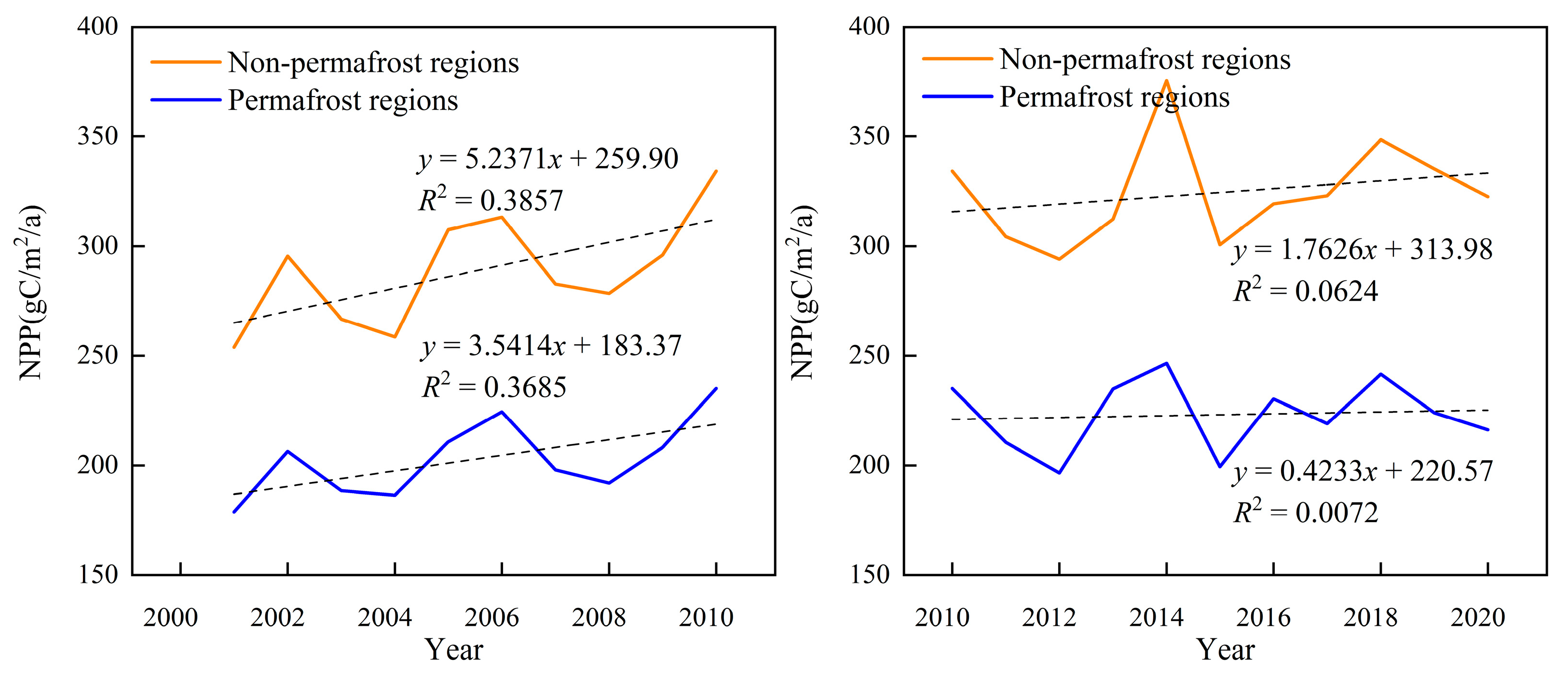
| Type | Area/km2 | LUCC Dynamics/% | |||
|---|---|---|---|---|---|
| 2000 | 2010 | 2020 | 2000–2010 | 2010–2020 | |
| Cultivated land | 451.41 | 448.48 | 447.11 | –0.06 | –0.03 |
| Woodland | 471.38 | 471.91 | 489.23 | 0.01 | 0.37 |
| Grassland | 18,599.93 | 18,561.83 | 18,514.35 | –0.02 | –0.03 |
| Water bodies | 5384.73 | 5339.16 | 5455.68 | –0.08 | 0.22 |
| Construction land | 21.39 | 111.89 | 132.15 | 42.32 | 1.81 |
| Unused land | 4741.93 | 4737.77 | 4632.84 | –0.01 | –0.22 |
| Comprehensive LUCC dynamics/% | \ | \ | \ | 7.78 | 3.04 |
| Year | LULC type | |||
|---|---|---|---|---|
| Cultivated Land | Woodland | Grassland | Unused Land | |
| 2001 | 277.83 | 291.56 | 192.24 | 158.04 |
| 2010 | 350.71 | 339.30 | 258.64 | 196.91 |
| 2020 | 363.54 | 319.56 | 244.00 | 174.88 |
| Mean | 330.69 | 316.81 | 231.63 | 176.61 |
| LULC Type | Factors | 2001–2010 | 2010–2020 | ||
|---|---|---|---|---|---|
| Influence Quantity/Tg C | Contribution Rate/% | Influence Quantity/Tg C | Contribution Rate/% | ||
| Cultivated land | LUCC | −0.36 | 2.38 | −0.21 | 8.69 |
| Climate change | 14.46 | 96.99 | 2.19 | 91.03 | |
| Woodland | LUCC | 0.07 | 0.64 | 2.77 | 55.97 |
| Climate change | 11.02 | 99.24 | 2.10 | 42.47 | |
| Grassland | LUCC | −135.88 | 0.59 | −227.89 | 4.21 |
| Climate change | 22,940.71 | 99.21 | −5165.52 | 95.54 | |
| Unused land | LUCC | −2.99 | 0.35 | −94.17 | 15.15 |
| Climate change | 851.48 | 99.56 | −516.04 | 83.01 | |
Disclaimer/Publisher’s Note: The statements, opinions and data contained in all publications are solely those of the individual author(s) and contributor(s) and not of MDPI and/or the editor(s). MDPI and/or the editor(s) disclaim responsibility for any injury to people or property resulting from any ideas, methods, instructions or products referred to in the content. |
© 2023 by the authors. Licensee MDPI, Basel, Switzerland. This article is an open access article distributed under the terms and conditions of the Creative Commons Attribution (CC BY) license (https://creativecommons.org/licenses/by/4.0/).
Share and Cite
Zhang, J.; Qi, Y.; Yang, R.; Ma, X.; Zhang, J.; Qi, W.; Guo, Q.; Wang, H. Impacts of Climate Change and Land Use/Cover Change on the Net Primary Productivity of Vegetation in the Qinghai Lake Basin. Int. J. Environ. Res. Public Health 2023, 20, 2179. https://doi.org/10.3390/ijerph20032179
Zhang J, Qi Y, Yang R, Ma X, Zhang J, Qi W, Guo Q, Wang H. Impacts of Climate Change and Land Use/Cover Change on the Net Primary Productivity of Vegetation in the Qinghai Lake Basin. International Journal of Environmental Research and Public Health. 2023; 20(3):2179. https://doi.org/10.3390/ijerph20032179
Chicago/Turabian StyleZhang, Jinlong, Yuan Qi, Rui Yang, Xiaofang Ma, Juan Zhang, Wanqiang Qi, Qianhong Guo, and Hongwei Wang. 2023. "Impacts of Climate Change and Land Use/Cover Change on the Net Primary Productivity of Vegetation in the Qinghai Lake Basin" International Journal of Environmental Research and Public Health 20, no. 3: 2179. https://doi.org/10.3390/ijerph20032179
APA StyleZhang, J., Qi, Y., Yang, R., Ma, X., Zhang, J., Qi, W., Guo, Q., & Wang, H. (2023). Impacts of Climate Change and Land Use/Cover Change on the Net Primary Productivity of Vegetation in the Qinghai Lake Basin. International Journal of Environmental Research and Public Health, 20(3), 2179. https://doi.org/10.3390/ijerph20032179






